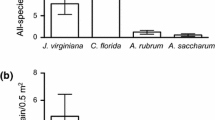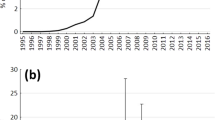Abstract
Fig trees (Ficus spp., Moraceae) are pollinated by species-specific fig wasps and have seeds that are mainly dispersed by fruit bats and birds. Consequently, they should be strongly dependent on mutualisms with animals for their reproductive success. As elsewhere in the Pacific, extinctions of potential seed dispersers have occurred on the islands in the southern Cook Islands archipelago. The abundance of the Pacific Banyan, Ficus prolixa, was found to be unrelated to the extent of potential seed disperser extinctions on different islands. There was no evidence of recruitment on Rarotonga, which has the most diverse bird and bat assemblage, and healthy populations on Mangaia, where all the native avian frugivores are extinct. Despite its very small population sizes on some of the islands, the trees pollinators are still present, showing that this mutualism has not yet been disrupted. Habitat loss, rather than a loss of mutualists, appears to be the main problem facing this species.
Similar content being viewed by others
References
Bond WJ (1995) Assessing the risk of plant extinction due to pollinator and disperser failure. In: Lawton JH and May RM (eds) Extinction Rates, pp 131–146. Oxford University Press, Oxford
Bregulla HL (1992) Birds of Vanuatu. Anthony Nelson, Oswestry
Corner EJH (1963) Ficus in the Pacific region. In: Gressitt JL (ed) Pacific Basin Biogeography, pp 233–245. Bishop Museum Press, Hawaii
Cushman JH (1995) Ecosystem-level consequences of species additions and deletions on islands. In: Vitousek PM, Loope LL and Adersen H (eds) Islands: Biological Diversity and Ecosystem Function, pp 135–147. Springer-Verlag, Berlin
Galil J (1977) Fig Biology. Endeavour 1: 52–56
McCormack G and Kunzle J (1995) Rarotonga's Mountain Tracks and Plants. Cook Islands Natural Heritage Project, Rarotonga
Pimm SL, Moulton MP and Justice LJ (1995) Bird extinctions in the central Pacific. In: Lawton JH and May RM (eds) Extinction Rates, pp 75–87. Oxford University Press, Oxford
McGrady-Steed J, Harris PM and Morin PJ (1997) Biodiversity regulates ecosystem predictability. Nature 390: 162–166
Steadman DW(1997) The historic biogeography and community ecology of Polynesian pigeons and doves. Journal of Biogeography 24: 737–753
Steadman DW and Kirch PV (1990) Prehistoric extinctions of birds on Mangaia, Cook islands, Polynesia. Proceedings of the National Academy of Sciences USA 87: 9605–9609
Thornton IWB, Compton SG and Wilson CN (1996) The role of animals in the colonization of the Krakatau islands by fig trees.Journal of Biogeography 23: 609–615
Wiebes JT (1994) The Indo-Australian Agaoninae (pollinators of figs). North Holland, Amsterdam
Author information
Authors and Affiliations
Rights and permissions
About this article
Cite this article
Compton, S., McCormack, G. The Pacific Banyan in the Cook Islands: have its pollination and seed dispersal mutualisms been disrupted, and does it matter?. Biodiversity and Conservation 8, 1707–1715 (1999). https://doi.org/10.1023/A:1008989022428
Issue Date:
DOI: https://doi.org/10.1023/A:1008989022428




